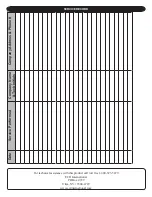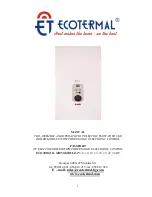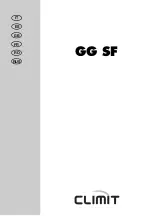
16
MAINTENANCE PROCEDURES
installed on the rear section of the boiler being careful not to
raise it above the opening of the hole. Skim until there are no
impurities. Repeat the process if necessary.
Water may be checked to make sure it is free from oil by
drawing off a sample at the skimming hole. If the sample
is reasonably free from oil, it will not froth when boiled on
stove. This test does not indicate the amount of sediment
which may lay in the bottom of the boiler. It is therefore nec
-
essary that the boiler be further cleaned by “blowing down.”
BLOWING DOWN THE BOILER
Before blowing down the boiler, fill it to the water line. Turn
on burner and allow five pounds of steam pressure to build
up. Run a temporary connection from one of the drain
valves to a nearby sewer. Connect to a drain valve on the
opposite end of the boiler from feed water inlet, if possible.
Shut off the oil burner, open drain valve and blow down the
entire contents of boiler.
Allow boiler to thoroughly cool and slowly refill to water line.
Repeat as many times as required until blow off water is
clear. Owner should blow down boiler at least once each
month of the heating season.
WATER WILL BE BOILING HOT.
WARNING
!
USING CLEANING COMPOUND
If an exceptional amount of dirt or sludge seems to be
present in the boiler, a boiler cleaning compound made by
a reputable manufacturer may be used according to the in
-
structions of the manufacturer of the compound. When any
type of cleaning compound is used, care must be taken to
thoroughly flush all traces of the compound out of the boiler.
Following blow down allow the boiler to cool. Add fresh
water slowly. Be certain to blow enough times as required
to remove compounds from system.
The area around the boiler must be kept clear and free
of combustible materials, gasoline and other flammable
vapors and liquids.
The free flow of combustion and ventilation air to the boiler
and boiler room must not be restricted or blocked.
Discharge will be boiling hot water and steam.
WARNING
!
The safety valve should open before the steam pressure
exceeds the 15 lb. reading on the gauge.
(
Figure #14
)
If
this pressure is exceeded and the safety valve does not
open, it must be replaced. If the safety valve leaks steam
when the boiler is operating at normal pressures, it should
be immediately replaced. Corrosion can build up rapidly
at the valve seat and prevent its functioning as a safety
device.
If the water in a steam boiler appears to be dirty or oily, or
the water level in the gauge glass fluctuates considerably,
the boiler should be cleaned. A competent service per
-
son will use approved cleaning compounds and properly
clean and flush out the boiler. He/she should also clean or
replace air vents and traps, clean flue passages and check
for proper operation of all controls and safety devices.
The venting system should be inspected at the start of each
heating season. Check the vent pipe from the boiler to the
chimney for signs of deterioration by rust or sagging joints.
Repair if necessary.
Impurities in boiler water
of a steam boiler may cause foam
-
ing and an unsteady water line, or prevent steam genera
-
tion. They may result in objectionable odors escaping from
the vents on water boilers. This condition is caused by oil,
grease, and sediment from pipe fittings collecting within
the boiler and can be remedied only by giving the boiler a
thorough cleaning.
BOILERS SHOULD BE CLEANED By SKIMMING OR
BLOWING DOWN.
The boiler should not be left unattended dur-
ing the cleaning process.
CAUTION
!
SKIMMING OFF IMPURITIES
Some of the impurities in the boiler water will float on the
water and must be skimmed off.
With the boiler empty and cool, slowly begin to add water.
After water has entered boiler - never before - turn “on” oil
burner and adjust water flow so that the water being added
is kept just below boiling point. Avoid boiling and turbu
-
lence.
Gradually raise hot water level to skimming hole
(
Figure #7
)









































